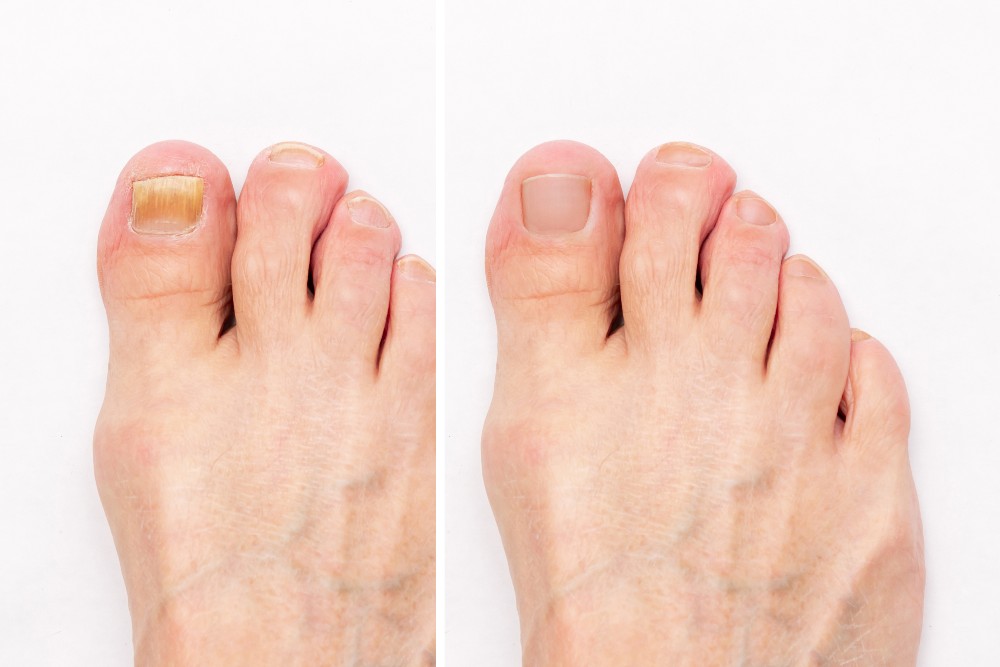Toenail Fungus
Although toenail fungus rarely cause physical pain, few can deny that these unsightly nail problems can be deeply frustrating and embarrassing. If you have them, you may feel reluctant to wear sandals, show your feet to others, or feel truly relaxed at the pool on a hot summer day.
If this describes you, take heart! There are a few things you should know:
- This condition is far more common than you probably realize. In fact, research suggests as many as 1 in 10 Americans have at least one fungal toenail.
- Although best results do take some time to achieve, fungal toenails are very treatable. You don’t have to live with them for the rest of your life!
Read on to learn more about this condition, and how the team at Community Foot Clinic of McPherson can help.

What is Toenail Fungus?
As the name suggests, toenail fungus (known medically as onychomycosis) is caused by fungi that get underneath the toenail. Specifically, those fungi are known as dermatophytes, and they feed off of keratin, a fibrous protein that is abundant in nails, skin, and hair.
Toenail fungus typically starts as a white or yellow spot under the tip of the nail. Over time, this patch grows and thickens, sometimes causing crumbling or further discoloration.
Beyond just being unsightly, toenail fungus is contagious and can spread to other nails on the foot if left untreated.
What are the Symptoms of Toenail Fungus?
The following are some of the most common symptoms of toenail fungus:
- Thickened nails: As the fungus spreads, it causes the nails to thicken. This may cause them to become misshapen as well.
- Brittle or ragged nails: The nails may become brittle or ragged as the fungus progresses.
- Discoloration: Yellowing is the most common sign of toenail fungus, but the nails may also become darker. In some cases, the nails may even take on a greenish hue.
- Crumbling nails: As the fungus causes the nails to thicken, they may also begin to crumble.
- Bad odor: In some cases, the nails may develop a bad odor.
- Pain: While toenail fungus itself is not painful, it can lead to problems such as ingrown nails, which can be quite painful.
What Causes Toenail Fungus?
Toenail fungus occurs as the result of fungi that infect the nails. The most common type of fungi is dermatophytes, which are also the cause of athlete’s foot. These fungi can thrive in warm, moist environments, which is why they often affect the nails.
Other types of fungi that can cause toenail fungus include yeasts and molds.
Who is Most at Risk of Fungal Infections?
Toenail fungus is more common in people who have certain conditions that make them more susceptible to fungal infections. Some of these conditions are:
- Athlete’s foot: This condition, which is caused by the same type of fungi that cause toenail fungus, makes the feet more susceptible to fungal infections.
- Psoriasis: This skin condition can make nails more brittle and susceptible to fungus.
- Diabetes: This condition can cause problems with circulation, which makes it more difficult for the body to fight off fungal infections.
- Peripheral Artery Disease (PAD): This condition can also cause problems with circulation, making it more difficult for the body to fight off fungal infections.
- Preexisting skin or nail injuries: Any injury to the nails or skin can make it more susceptible to fungal infections.
Other circumstantial factors that can play a role in toenail fungus include:
- Age: Older adults are more susceptible to fungal infections.
- Sweating: Sweating can create a warm, moist environment that is ideal for fungi to grow.
- Walking barefoot in communal areas: This can increase the risk of coming into contact with fungi.
- Having a weakened immune system: This makes it more difficult for the body to fight off fungal infections.
How Do I Get Rid of Fungal Toenails?
Unfortunately, toenail fungus can be somewhat stubborn to get rid of. The fungi are well protected under the nail, and due to the slow growth rate of toenails, it may take many months for optimal results.
While this can be discouraging for patients, we assure you that, with patience, diligence, and discipline, toenail fungus can be treated successfully!
First, we’ll conduct a proper examination to confirm a toenail fungus diagnosis. (There are other conditions that can cause similar symptoms, so we want to be sure.) From there, we will recommend an appropriate treatment course based on your lifestyle and medical history.
Some of the treatments available are:
- Oral medications: Oral antifungals tend to be the overall most effective treatment method, and require 8-12 weeks of taking a daily pill. Due to the possibility of side effects, it isn’t recommended for those with liver problems.
- Topical antifungals: Topicals are usually prescribed in conjunction with oral medications, as they can help stunt fungal growth. Given the difficulty of penetrating the nail plate, they are less effective when used on their own.
- Antifungal lacquers: This is medicated nail polish that you apply to the nail as well as the surrounding skin. It creates a clear, nonporous fungicidal coating that is much more effective at treating the infection than more traditional topical antifungal creams. However, it is not recommended for those with compromised immune systems.
- Nail removal: In severe cases, the nail can be removed and the infection underneath treated directly.
Early detection and treatment is the most important factor in determining whether more conservative forms of treatment will provide good results. But that doesn’t mean even severe cases cannot be treated successfully!
How do I Prevent Toenail Fungus?
There are a few things you can do to help prevent toenail fungus, or at least prevent more growth:
- Wash your feet regularly: This helps to remove any fungus that may be on your feet.
- Keep your feet dry: Fungi thrive in moist environments, so keeping your feet dry can help prevent them from growing.
- Wear shoes in public places: This helps to protect your feet from coming into contact with fungi.
- Trim nails straight across: This helps to prevent ingrown nails, which can provide an entry point for fungi.
- Disinfect nail clippers after each clipping: This helps to prevent the spread of fungi to other nails and to other people. However, it would be best not to share your nail clippers with other people.
- Wear moisture-wicking socks or change socks regularly: This helps to keep your feet dry and prevent the growth of fungi.
- Discard old shoes: Old shoes can be a breeding ground for fungi – foregoing them in favor of new shoes can help lessen your risk of developing nail fungus.
- Choose shoes made from breathable materials: Breathable materials help to keep your feet dry and prevent the growth of fungi.
- Wear footwear in damp communal areas like shower shoes: This helps to protect your feet from coming into contact with fungi. Wearing footwear like flip-flops in public damp areas will also help protect your feet from plantar warts.
- Use antifungal powders or sprays: These can help to prevent the growth of fungi. You can even spray or put the powder in your shoes at the end of the day to help prevent fungus from growing in your shoes.
Toenail Fungus? Contact Us Today for Help!
If you think you may have toenail fungus, it’s important to see our doctor so that he can diagnose the condition and recommend treatment.
At Community Foot Clinic of McPherson, our team can help you get to the bottom of your toenail fungus and develop a treatment plan that’s right for you. Contact us today to schedule an appointment. We look forward to helping you get back to clear toenails!
McPherson Office
316 W. 4th Street
McPherson, KS 67460
P: (620) 241-3313
F: (620) 241-6967
© Community Foot Clinic of McPherson. All Rights Reserved.
Privacy Policy | Terms & Conditions
Web Design by CP Solutions
Marketed by VMD Services


